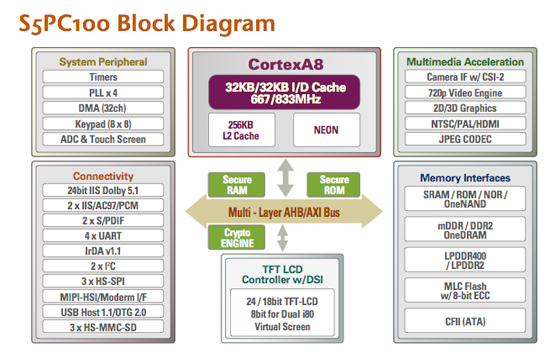The iPhone 3GS Hardware Exposed & Analyzed
by Anand Lal Shimpi on June 10, 2009 12:00 AM EST- Posted in
- Smartphones
- Mobile
Enter the ARM Cortex A8
This past weekend Palm introduced its highly anticipated Pre. While I’m still working on my review of the Pre, I can say that it’s the closest thing to an iPhone since Apple first unveiled the product two summers ago. In many ways the Pre is lacking in areas that the iPhone has honestly perfected, but in others the Pre easily surpasses Apple’s best.
One such area is raw performance. While both the iPhone and iPhone 3G use the same old CPU/GPU, the Pre uses TI’s OMAP 3430 processor. The 3430, like the SoC Apple uses, has both a CPU and GPU on the same package. Instead of the ARM11 and the PowerVR MBX-Lite however, the OMAP 3430 uses an ARM Cortex A8 core and a PowerVR SGX GPU. Both are significant improvements over what was in the original iPhone.
Thankfully, Apple fans don’t have to be outclassed for long - the newly announced iPhone 3GS uses a comparable CPU/GPU pair.
Although unannounced, the iPhone 3GS uses (again) a Samsung SoC but this time instead of the ARM11 + MBX-Lite combo it’s got a Cortex A8 and PowerVR SGX; just like the Pre.

A derivative of this is what you'll find in the iPhone 3GS
If the ARM11 is like a modern day 486 with a very high clock speed, the Cortex A8 is like a modern day Pentium. The A8 lengthens the integer pipeline to 13 stages, enabling its 600MHz clock speed (what I’m hearing the 3GS runs at). The Cortex A8 also widens the processor; the chip is now a two-issue in-order core, capable of fetching, decoding and executing two RISC instructions in parallel.
The ARM11 processor in the iPhone/iPhone 3G has a basic vector floating point unit, but the A8 adds a much more advanced SIMD engine called NEON. The A8 also has twice as many double precision FP registers as the ARM11. The addition of NEON and the improved vector FPU in the A8 makes the processor much less like the original Pentium and much more like Intel’s Atom. Granted, Atom is significantly faster than the A8, but it also draws much more power.
Caches also get a significant improvement. I believe Apple will be using a derivative of Samsung’s S5PC100, which has a 32KB/32KB L1 cache (I/D, we may see a 16KB/16KB config instead) and a 256KB L2 cache. The L2 cache, as you’ll remember from the first section, is a new addition to the A8; the ARM11 core didn’t have an L2.
| iPhone 3G (ARM11) | iPhone 3GS (ARM Cortex A8) | |
| Manufacturing Process | 90nm | 65nm |
| Architecture | In-Order | In-Order |
| Issue Width | 1-issue | 2-issue |
| Pipeline Depth | 8-stage | 13-stage |
| Clock Speed | 412MHz | 600MHz |
| L1 Cache Size | 16KB I-Cache + 16KB D-Cache | 32KB I-Cache + 32KB D-Cache |
| L2 Cache Size | N/A | 256KB |
The combination of higher clock speeds, more cache and a dual-issue front end results in a much faster processor. Apple claims the real world performance of the iPhone 3GS can be up to 2x faster than the iPhone 3G, and I believe that’s quite feasible.

The new SoC is built on a 65nm manufacturing process, down from 90nm in the original hardware. However, power consumption should still be higher for the new SoC compared to the old one. ARM’s own site lists ~0.25mW per MHz for the ARM11 core but < 0.59mW per MHz for the A8. That’s for a 650MHz low power A8 core and I’m expecting 600MHz for the 3GS, that’s at most 3x the power consumption of the CPU in the original iPhone. So how can Apple promise better battery life?
The thing about these comparisons is that they don’t show the full picture. With the same battery capacity, running at full speed, the new iPhone 3GS would run out of juice faster than the existing iPhone 3G. But that’s rarely how people use their phones. Chances are that you’ll perform a few tasks before putting the phone back to sleep, and what matters then is how quickly you can complete those tasks.
Just under nine years ago Intel talked about a technology called Quick Start. Let me quote from our IDF 2000 Day 2 coverage (wow, that was a while ago):
“"Intel has figured out that it is best to use full CPU power for a split second to finish a task and then put the CPU to idle as this conserves battery life the best. Although one may suspect that when running complex operations the CPU would not have time to go idle, this is not the case. To illustrate this point, Intel used an example of DVD playback. Very stressful on the system as a whole, Intel's quick start technology allows the CPU to "hurry up" and perform the DVD decoding operations and then go idle until the frame is displayed to screen and the next scene needs to be calculated. This saves battery life because, although the system may require 3 watts or so to "hurry up", the power consumption goes down near .25 watts when idle. By averaging these two numbers, one can quickly see how quick start can extend battery life."”
The A8’s power consumption has to be well under that 3x max I quoted above, and the iPhone 3GS needs to be more than just 2x faster at executing instructions, but if possible then it’s quite feasible for the faster A8 to draw more instantaneous power but draw less power on average than the ARM11 core in the original iPhone.










65 Comments
View All Comments
araczynski - Monday, June 15, 2009 - link
blah blah blah same crappy gameboy resolution screen blah blah blah talk to nokia blah blah blah.maybe if half the price of the stupid thing went into the device instead of paying for all the worthless marketing they'd have a killer device that i would gladly pay $130 a month for for unlimited data service.
ah well, maybe in a few years.
punkball - Saturday, June 13, 2009 - link
I dunno why ,i have a good feelingnot knowing much at all about (only what seems to be a negative
evaluation on parts; by the community).
This phone its main uphearst performace being, we'll see a comprised Flash/Flex player on the iTunes store ?a good deal onwards agreed on a Mac-device friendly version of the Flash Player?? Anyone else hoping/caring?
lateef - Friday, June 12, 2009 - link
does anyone know if the radio/wireless chipset been upgraded in the 3gs rather than a tweakiwodo - Friday, June 12, 2009 - link
Arh, interesting question. I think everyone were too concentrated on its CPU, Memory and GPU and forgot the most fundamental / important issues.To be honest iPhone is rather weak for its Radio Reception. I think this is partly due to Infineon are new to Mobile Chipset.
Is there an updated chipset to fix iPhone Comparatively poor quality reception?
( Last time i heard the 7.2Mbps speed increase has to do with Firmware unlocking, so i am not sure if the chipset has been updated )
PhilipOrr - Friday, June 12, 2009 - link
Was talking with the Apple engineers at WWDC which technical data sheets to look up concerning the GPU within the new iPhone. It's the PowerVR SGX 535.This chip is one up from the Palm Pre which is the PowerVR SGX 530.
The difference between these is more video based than anything else. 535 has hardware acceleration for H.264 encode/decode, MPEG 4 and JPEG. It also handles HD content to 720p in real time.
These specs seem to give a hint to what Apple are planning for future upgrades of the iPhone or other device. Suggesting, that if your developing for the 3GS then you're already developing for the next generation too.
jasaero - Friday, June 12, 2009 - link
My guess is that the 535 was used more for optimizing the video option on the phone than for any future planned uses. Not required to do video, but is extremely useful in reducing file sizes of video output and may help with some of the video editing functionality it supossedly has. So far Apple hasn't really preplanned any added functionality so much as reacted to demand for certain features they seemed to have left out useablity and performance trade off. Copy, cut, paste being the most glaring example. Basically I am quite doubtful they have a handset like the Omnia HD that probably uses this same chip in their sights just yet.iwodo - Thursday, June 11, 2009 - link
I really hope anand do some detail article on Mobile Tech. MIPS, ARM, difference between ARMv6 and v7. SnapDragon and OMAP. I mean if iPhone uses a SOC that is 90% the same as TI's OMAP, why not just buy it from OMAP? Do different implementation of ARM matters? How does Tegra compare to SGX, what about Mani ( ARM ) 's graphics department?There are about 10 dozens more questions i hope anand could answer. The truth is, as a tech news reader, i haven't been as excited as this for a long time. PC are already way too powerful then 90%+ of our needs. That is why Netbook are so popular. They are cheap, and gets the job done.
The next battle, and most interesting development in the next decade will be on Mobile front. Where ARM and PowerVR dominate. PC tech are used to Intel and ATI/Nvidia so ARM and PowerVR's tech are Alien to us.
I really hope there will be more in depth article about Mobile Technology. The only thing that interest me in PC is development of SSD.
Anand Lal Shimpi - Friday, June 12, 2009 - link
I've been dabbling in it for a while but I think I agree with you. Such a comparison may be necessary. I'm going to start chasing some of these technologies and see where I end up. If I find something sufficiently interesting, I'll be sure to share :)Take care,
Anand
iwodo - Friday, June 12, 2009 - link
Thanks. Hoping for more ARM info soon.Regards
AnnonymousCoward - Friday, June 12, 2009 - link
I agree. Apple should be buying OMAP instead of the ASIC. I think digital camera companies will be going that route too.